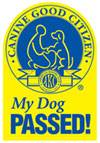 |
| © AllThingsDogBlog.com Time = Bond |
There are many ways we can help our kids build a bond with their dogs that will last throughout their time together. Following are a few of the tips that come to mind. What are yours?
- Make the decision about when your child is ready for more responsibility with great care. Complete respect for your dog's health and safety, as well as that of other children, is imperative.
- Let your kids feed your pets during the Summer. Dogs generally bond more closely to those that provide their nourishment.
- Offer safety tips and do's and don'ts when are kids are learning to feed your pets. Understanding food and toy aggression is important to their safety.
- Encourage your kids to play outdoors when taking their dog along on neighborhood play dates. Keeping Fido on a leash is an important part of that rule, and this time will allow your older kids to get a better understanding of the care and decision-making that goes into pets that are tagalongs.
- When friends come to your home to play with your kids, discourage rambunctious play in favor of games that may include your dog. Hide-n-Seek, Fetch, Frisbee, and Laser Tag are great fun for kids and their dogs. Be sure to monitor their activities and let them know you are supervising. Your dog will appreciate your concern as much as their attentions.
- As much as I'm a dog park lover, I don't believe this is a terrific place for kids under the age of about 10 or possibly even 12. Even at this age, your son or daughter will need much instruction to be safe and enjoy the experience. Check out these tips: Dog Park Safety Challenges for Children and Dog Park Visits: Preparing Kids for a Safe First Experience.
- Beyond adolescence you'll find your kids may take their own path in regard to spending time with their dog. Building this relationship before that time is important to cementing it for the future. College homecomings are wonderful when Fido greets his "kid" at the door happily.
-









































